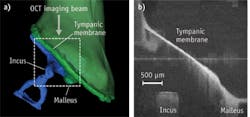OPTICAL COHERENCE TOMOGRAPHY/AUDIOLOGY: OCT demonstrated for clinical and research application to hearing loss assessment
Recently, researchers broke ground on a new application for optical coherence tomography (OCT) when they made the first-ever demonstration of structural and functional imaging of human middle ear micro structures. The researchers also demonstrated the diagnostic utility of their approach, and since then at least a couple of groups used the method for both clinical and basic studies.
"Using this method, we could image nanoscale motion of ear drum and ossicles in the human middle ear," explained Hrebesh M. Subhash, lead author on a paper describing the approach.1 This means the approach sheds light on an area no standard hearing test today can measure. Although OCT had been demonstrated previously for imaging the morphology of the human middle ear and tympanic membrane, its application for middle vibrometry in humans had not been reported.
The study demonstrated the use of spectral-domain phase-sensitive (SD-PS) OCT for imaging depth-resolved vibration of middle ear structures through the intact tympanic membrane, and its diagnostic utility on a human cadaver temporal bone. The researchers say this suggests that there may be applications in the diagnosis and preclinical evaluation of middle ear abnormalities. Hearing loss is the world's most common sensory disorder, affecting approximately 17% of American adults.
1. H. M. Subhash et al., J. Biomed. Opt., 17, 6, 060505 (2012); doi:10.1117/1.JBO.17.6.060505.
